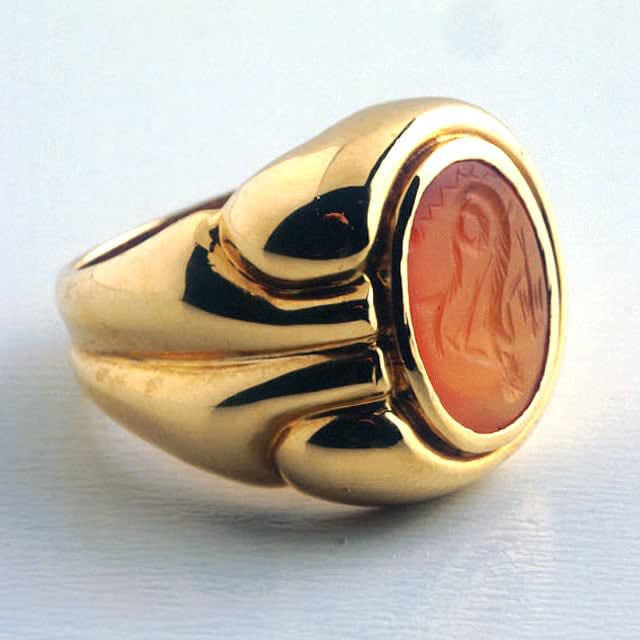Roman Carnelian Intaglio Depicting the God Neptune, 100 CE - 200 CE
Carnelian-Gold
FJ.5096
Mounted in a beautiful 18 karat gold ring. The art of glyptics, or carving images on colored precious stones, is probably one of the oldest known to humanity. Intaglios, gems...
Mounted in a beautiful 18 karat gold ring.
The art of glyptics, or carving images on colored precious stones, is probably one of the oldest known to humanity. Intaglios, gems with an incised design, were made as early as the fourth and third millennia B.C. in Mesopotamia and the Aegean Islands. They exhibit a virtuosity of execution that suggests an old and stable tradition rooted in the earliest centuries. The tools required for carving gems were simple: a wheel with a belt-drive and a set of drills. Abrasives were necessary since the minerals used were too hard for a metal edge. A special difficulty of engraving intaglios, aside from their miniature size, was that the master had to work with a mirror-image in mind.
In this small intaglio the delicate and masterful carving of Neptune is soft and curvilinear, its beauty at once enhanced by the pure color of the stone. Clearly, the creation of intaglios such as this was done for a love of the beautiful. How fortunate we are that the extreme hardness of these semiprecious gemstones makes their beauty truly everlasting, unaffected by the flow of the centuries. This magnificent depiction of Neptune, set in a gold ring that complements its radiant beauty, is as spirited and lovely as the day it was carved.
The art of glyptics, or carving images on colored precious stones, is probably one of the oldest known to humanity. Intaglios, gems with an incised design, were made as early as the fourth and third millennia B.C. in Mesopotamia and the Aegean Islands. They exhibit a virtuosity of execution that suggests an old and stable tradition rooted in the earliest centuries. The tools required for carving gems were simple: a wheel with a belt-drive and a set of drills. Abrasives were necessary since the minerals used were too hard for a metal edge. A special difficulty of engraving intaglios, aside from their miniature size, was that the master had to work with a mirror-image in mind.
In this small intaglio the delicate and masterful carving of Neptune is soft and curvilinear, its beauty at once enhanced by the pure color of the stone. Clearly, the creation of intaglios such as this was done for a love of the beautiful. How fortunate we are that the extreme hardness of these semiprecious gemstones makes their beauty truly everlasting, unaffected by the flow of the centuries. This magnificent depiction of Neptune, set in a gold ring that complements its radiant beauty, is as spirited and lovely as the day it was carved.
